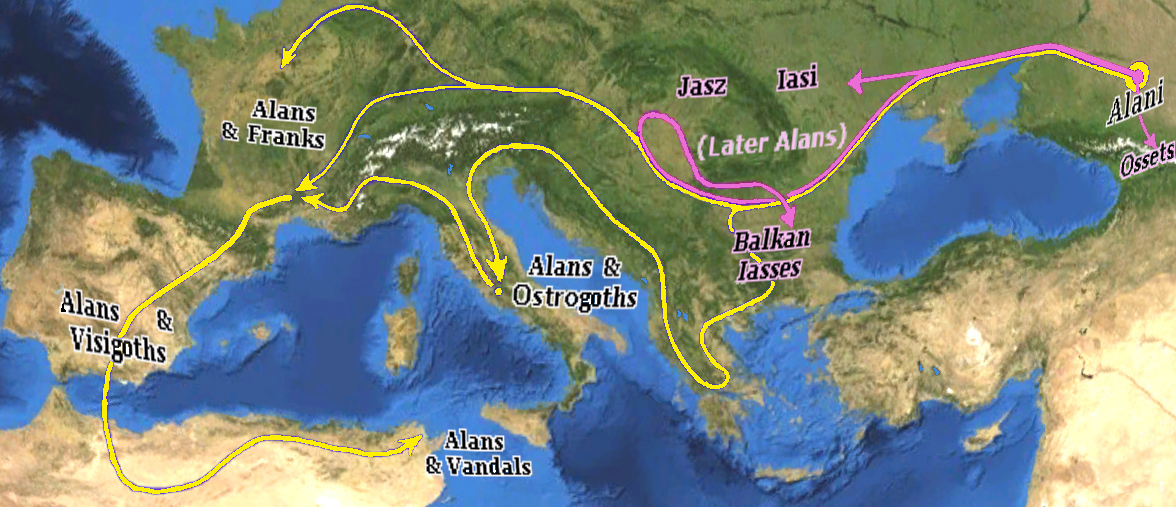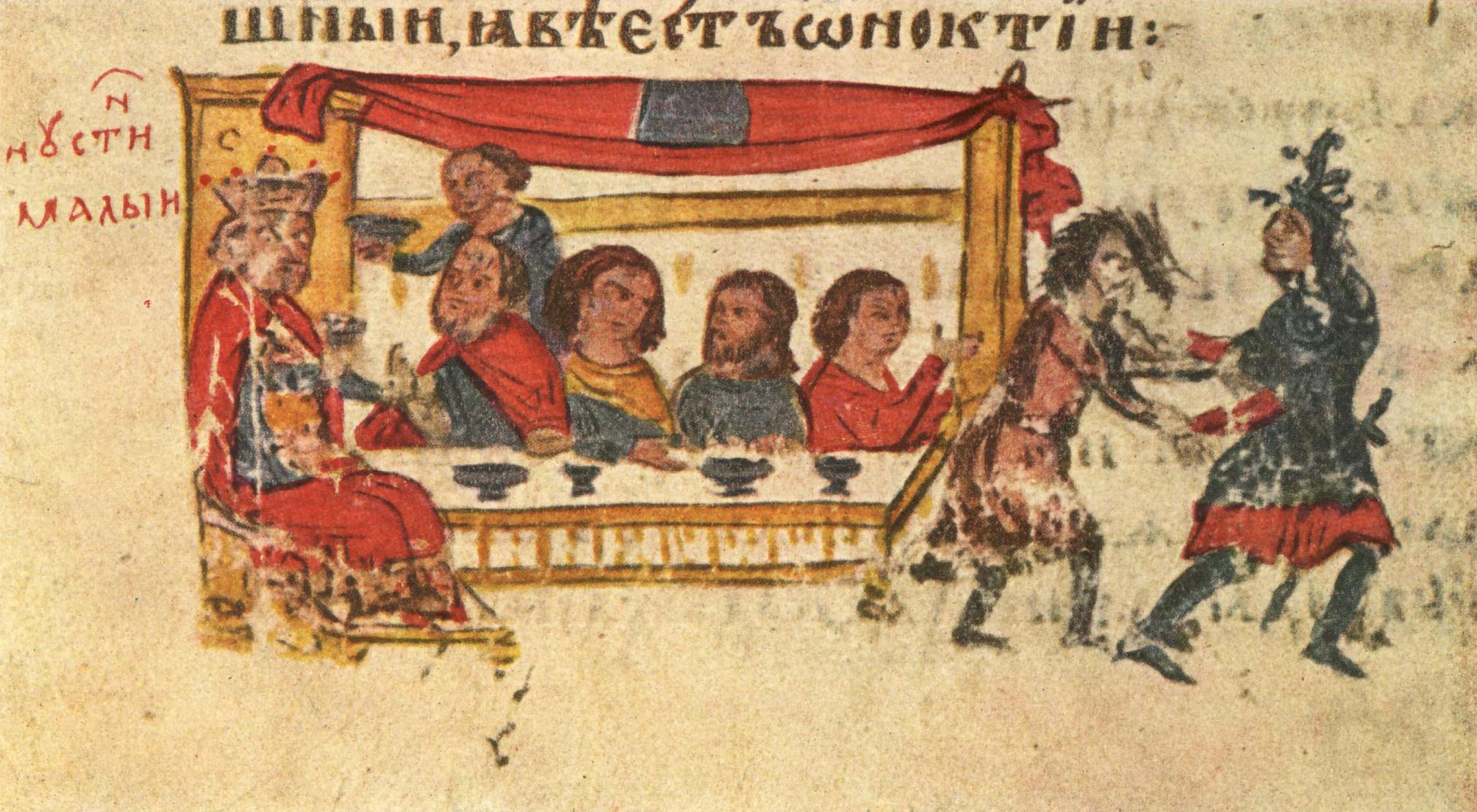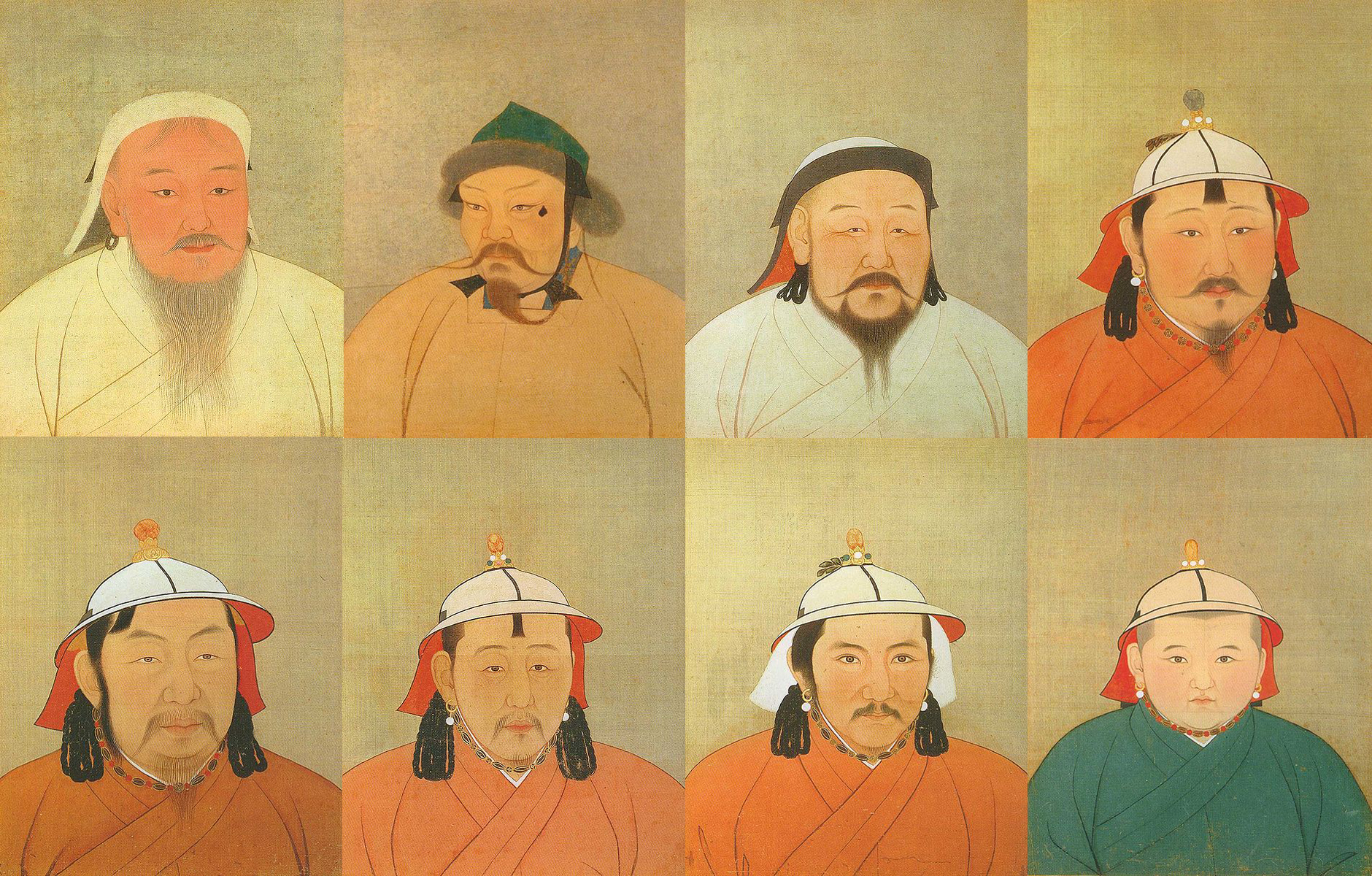|
Sarosius
Sarosius ( el, ΣαÏÏÏÎčÎżÏ, ), also called Sarodius (ΣαÏÏÎŽÎčÎżÏ ''Saráčdios'') or Saroes {{IPAc-en, Ë, s, ĂŠ, r, oÊ-, iË, z (ΣαÏÏÎ·Ï ''SarĂłÄs''), was the king of the Alans in the early 6th century while they were still in Ukraine. He acted as diplomatic negotiator between the Central Asian Pseudo-Avar refugees led by Kandik and the Byzantine emperor Justinian I in 557 and then again between Justin II and the Turks in 569. From the latter we learn that the Avars whom Sarosios helped in 557 were in fact renegades from the Hephthalites (who surrendered to the GöktĂŒrks and Sassanid Persia in 567) and apparently had no right to use the title of Avar Khagan. The diplomatic ties that Sarosios fostered led to the GöktĂŒrks' agreement with Emperor Maurice in 598,Theophylact Simocatta, Ed. Bonn, 282ff, Chavannes, Documents, 246ff to support a ruler, Sandilch Sandilch (''ÎŁÎŹÎœÎŽÎčλ'', ''ÎŁÎŹÎœÎŽÎčλÏÎżÏ''; Turkic "boat) was a chieftain of the Utigur Bulgars i ... [...More Info...] [...Related Items...] OR: [Wikipedia] [Google] [Baidu] |
Kandik
Kandik or Kazrig was one of the three Scythian brothers mentioned in the chronicle of Michael of Syria, the Jacobite Patriarch of Antioch. After leading their Iverian people as refugees away from the Turks as Pseudo-Avar khagans, Kazrig and his brothers Bolgaris and Bayan I approached Sarosius to mediate for him with the Byzantine Empire in 557. They soon conquered the remnant of the Akatziri Hunno-Bulgars also known as Kutrigurs from the time of Ernak Ernak was the last known ruler of the Huns, and the third son of Attila. After Attila's death in 453 AD, his Empire crumbled and its remains were ruled by his three sons, Ellac, Dengizich and Ernak. He succeeded his older brother Ellac in 454 AD, an .... References 562 deaths 6th-century monarchs in Europe Year of birth unknown Pannonian Avars {{Ukraine-hist-stub ... [...More Info...] [...Related Items...] OR: [Wikipedia] [Google] [Baidu] |
Alans
The Alans (Latin: ''Alani'') were an ancient and medieval Iranian nomadic pastoral people of the North Caucasus â generally regarded as part of the Sarmatians, and possibly related to the Massagetae. Modern historians have connected the Alans with the Central Asian Yancai of Chinese sources and with the Aorsi of Roman sources. Having migrated westwards and becoming dominant among the Sarmatians on the PonticâCaspian steppe, the Alans are mentioned by Roman sources in the . At that time they had settled the region north of the Black Sea and frequently raided the Parthian Empire and the Caucasian provinces of the Roman Empire. From the Goths broke their power on the Pontic Steppe. Upon the Hunnic defeat of the Goths on the Pontic Steppe around , many of the Alans migrated westwards along with various Germanic tribes. They crossed the Rhine in 406CE along with the Vandals and Suebi, settling in OrlĂ©ans and Valence. Around 409 CE they joined the Vandals and S ... [...More Info...] [...Related Items...] OR: [Wikipedia] [Google] [Baidu] |
Ukraine
Ukraine ( uk, ĐŁĐșŃĐ°ŃĐœĐ°, UkraĂŻna, ) is a country in Eastern Europe. It is the second-largest European country after Russia, which it borders to the east and northeast. Ukraine covers approximately . Prior to the ongoing Russian invasion, it was the eighth-most populous country in Europe, with a population of around 41 million people. It is also bordered by Belarus to the north; by Poland, Slovakia, and Hungary to the west; and by Romania and Moldova to the southwest; with a coastline along the Black Sea and the Sea of Azov to the south and southeast. Kyiv is the nation's capital and largest city. Ukraine's state language is Ukrainian; Russian is also widely spoken, especially in the east and south. During the Middle Ages, Ukraine was the site of early Slavic expansion and the area later became a key centre of East Slavic culture under the state of Kievan Rus', which emerged in the 9th century. The state eventually disintegrated into rival regional powers and ... [...More Info...] [...Related Items...] OR: [Wikipedia] [Google] [Baidu] |
Pseudo-Avar
The Pannonian Avars ( ) were an alliance of several groups of Eurasian nomads of various origins. The peoples were also known as the Obri in the chronicles of the Rus, the Abaroi or Varchonitai (), or Pseudo-Avars in Byzantine sources, and the Apar () to the GöktĂŒrks. They established the Avar Khaganate, which spanned the Pannonian Basin and considerable areas of Central and Eastern Europe from the late 6th to the early 9th century. The name Pannonian Avars (after the area in which they settled) is used to distinguish them from the Avars of the Caucasus, a separate people with whom the Pannonian Avars may or may not have had links. Although the name ''Avar'' first appeared in the mid-5th century, the Pannonian Avars entered the historical scene in the mid-6th century, on the PonticâCaspian steppe as a people who wished to escape the rule of the GöktĂŒrks. They are probably best known for their invasions and destruction in the AvarâByzantine wars from 568 to 626 and influ ... [...More Info...] [...Related Items...] OR: [Wikipedia] [Google] [Baidu] |
Byzantine Emperor
This is a list of the Byzantine emperors from the foundation of Constantinople in 330 AD, which marks the conventional start of the Eastern Roman Empire, to its fall to the Ottoman Empire in 1453 AD. Only the emperors who were recognized as legitimate rulers and exercised sovereign authority are included, to the exclusion of junior co-emperors (''symbasileis'') who never attained the status of sole or senior ruler, as well as of the various usurpers or rebels who claimed the imperial title. The following list starts with Constantine the Great, the first Christian emperor, who rebuilt the city of Byzantium as an imperial capital, Constantinople, and who was regarded by the later emperors as the model ruler. It was under Constantine that the major characteristics of what is considered the Byzantine state emerged: a Roman polity centered at Constantinople and culturally dominated by the Greek East, with Christianity as the state religion A state religion (also called relig ... [...More Info...] [...Related Items...] OR: [Wikipedia] [Google] [Baidu] |
Justinian I
Justinian I (; la, Iustinianus, ; grc-gre, áŒžÎżÏ ÏÏÎčÎœÎčαΜÏÏ ; 48214 November 565), also known as Justinian the Great, was the Byzantine emperor from 527 to 565. His reign is marked by the ambitious but only partly realized ''renovatio imperii'', or "restoration of the Empire". This ambition was expressed by the partial recovery of the territories of the defunct Western Roman Empire. His general, Belisarius, swiftly conquered the Vandal Kingdom in North Africa. Subsequently, Belisarius, Narses, and other generals conquered the Ostrogothic kingdom, restoring Dalmatia, Sicily, Italian peninsula, Italy, and Rome to the empire after more than half a century of rule by the Ostrogoths. The Liberius (praetorian prefect), praetorian prefect Liberius reclaimed the south of the Iberian peninsula, establishing the province of Spania. These campaigns re-established Roman control over the western Mediterranean, increasing the Empire's annual revenue by over a million Solidus (coin) ... [...More Info...] [...Related Items...] OR: [Wikipedia] [Google] [Baidu] |
Justin II
Justin II ( la, Iustinus; grc-gre, áŒžÎżÏ ÏÏáżÎœÎżÏ, IoustĂźnos; died 5 October 578) or Justin the Younger ( la, Iustinus minor) was Eastern Roman Emperor from 565 until 578. He was the nephew of Justinian I and the husband of Sophia, the niece of the Empress Theodora, and was therefore a member of the Justinian dynasty. Justin II inherited a greatly enlarged but overextended empire, with far less resources at his disposal compared to Justinian I. Despite this, he strived to match his formidable uncle's reputation by abandoning the payment of tributes to the Empire's neighbors. This miscalculated move resulted in rekindling of war with the Sassanid Empire, and in a Lombard invasion which cost the Romans much of their territory in Italy. Family He was a son of Vigilantia and Dulcidio (sometimes rendered as Dulcissimus), respectively the sister and brother-in-law of Justinian. His siblings included Marcellus and Praejecta. With Sophia he had a daughter Arabia and possib ... [...More Info...] [...Related Items...] OR: [Wikipedia] [Google] [Baidu] |
Hephthalites
The Hephthalites ( xbc, ηÎČοΎαλο, translit= Ebodalo), sometimes called the White Huns (also known as the White Hunas, in Iranian as the ''Spet Xyon'' and in Sanskrit as the ''Sveta-huna''), were a people who lived in Central Asia during the 5th to 8th centuries CE. They formed an empire, the Imperial Hephthalites, and were militarily important from 450 CE, when they defeated the Kidarites, to 560 CE, when combined forces from the First Turkic Khaganate and the Sasanian Empire defeated them. After 560 CE, they established "principalities" in the area of Tokharistan, under the suzerainty of the Western Turks (in the areas north of the Oxus) and of the Sasanian Empire (in the areas south of the Oxus), before the Tokhara Yabghus took over in 625. The Imperial Hephthalites, based in Bactria, expanded eastwards to the Tarim Basin, westwards to Sogdia and southwards through Afghanistan, but they never went beyond the Hindu-Kush, which was occupied by the Alchon Huns, prev ... [...More Info...] [...Related Items...] OR: [Wikipedia] [Google] [Baidu] |
GöktĂŒrks
The GöktĂŒrks, Celestial Turks or Blue Turks ( otk, đ± đ°đ°Œđ°°:đ°đ°đ°đ°Ł, TĂŒrĂŒk Bodun; ; ) were a nomadic confederation of Turkic peoples in medieval Inner Asia. The GöktĂŒrks, under the leadership of Bumin Qaghan (d. 552) and his sons, succeeded the Rouran Khaganate as the main power in the region and established the First Turkic Khaganate, one of several nomadic dynasties that would shape the future geolocation, culture, and dominant beliefs of Turkic peoples. Etymology Origin Strictly speaking, the common name "GöktĂŒrk" emerged from the misreading of the word "Kök" meaning Ashina, ruling clan of the historical ethnic group's endonym: which was attested as otk, đ± đ°đ°Œđ°°, TĂŒrĂŒk, labels=no ''trwkc'', ''trukÄ''; Khotanese Saka ''TtĆ«rka''/''TtrĆ«ka'', Ruanruan ''toÌ€roÌ€x''/''tĂŒrÇg'' and Old Tibetan ''Drugu''. Definition According to Chinese sources, TĆ«juĂ© meant "combat helmet" (), reportedly because the shape of the Altai Mountains, w ... [...More Info...] [...Related Items...] OR: [Wikipedia] [Google] [Baidu] |
Sassanid Persia
The Sasanian () or Sassanid Empire, officially known as the Empire of Iranians (, ) and also referred to by historians as the Neo-Persian Empire, was the History of Iran, last Iranian empire before the early Muslim conquests of the 7th-8th centuries AD. Named after the Sasanian dynasty, House of Sasan, it endured for over four centuries, from 224 to 651 AD, making it the longest-lived List of monarchs of Persia, Persian imperial dynasty. The Sasanian Empire succeeded the Parthian Empire, and re-established the Persians as a major power in late antiquity alongside its neighbouring arch-rival, the Roman Empire (after 395 the Byzantine Empire).Norman A. Stillman ''The Jews of Arab Lands'' pp 22 Jewish Publication Society, 1979 International Congress of Byzantine Studies ''Proceedings of the 21st International Congress of Byzantine Studies, London, 21â26 August 2006, Volumes 1â3'' pp 29. Ashgate Pub Co, 2006 The empire was founded by Ardashir I, an Iranian ruler who rose to po ... [...More Info...] [...Related Items...] OR: [Wikipedia] [Google] [Baidu] |
Khagan
Khagan or Qaghan (Mongolian:; or ''Khagan''; otk, đ°Žđ°đ°Ł ), or , tr, KaÄan or ; ug, ÙۧŰșۧÙ, Qaghan, Mongolian Script: ; or ; fa, ۟ۧÙŰ§Ù ''KhÄqÄn'', alternatively spelled KaÄan, Kagan, Khaghan, Kaghan, Khakan, Khakhan, Khaqan, Xagahn, Qaghan, Chagan, ÒĐ°Đœ, or Kha'an is a title of imperial rank in the Turkic, Mongolic and some other languages, equal to the status of emperor and someone who rules a khaganate (empire). The female equivalent is Khatun. It may also be translated as "Khan of Khans", equivalent to King of Kings. In Bulgarian, the title became known as ''Khan'', while in modern Turkic, the title became ''Khaan'' with the ''g'' sound becoming almost silent or non-existent; the ''Ä'' in modern Turkish ''KaÄan'' is also silent. Since the division of the Mongol Empire, monarchs of the Yuan dynasty and the Northern Yuan held the title of ''Khagan''. ''KaÄan, Hakan'' and ''Kaan'', Turkish equivalents of the title are common Turkish names ... [...More Info...] [...Related Items...] OR: [Wikipedia] [Google] [Baidu] |
Maurice (emperor)
Maurice ( la, Mauricius or ''Mauritius''; ; 539 â 27 November 602) was Eastern Roman emperor from 582 to 602 and the last member of the Justinian dynasty. A successful general, Maurice was chosen as heir and son-in-law by his predecessor Tiberius II. Maurice's reign was troubled by almost constant warfare. After he became emperor, he brought the war with Sasanian Persia to a victorious conclusion. The empire's eastern border in the South Caucasus was vastly expanded and, for the first time in nearly two centuries, the Romans were no longer obliged to pay the Persians thousands of pounds of gold annually for peace. Afterward, Maurice campaigned extensively in the Balkans against the Avarsâpushing them back across the Danube by 599. He also conducted campaigns across the Danube, the first Roman emperor to do so in over two centuries. In the west, he established two large semi-autonomous provinces called exarchates, ruled by ''exarchs'', or viceroys of the emperor. In It ... [...More Info...] [...Related Items...] OR: [Wikipedia] [Google] [Baidu] |







